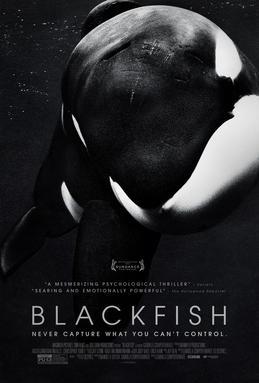Submitted by literature on

The documentary Blackfish covers the life of Tilikum, an orca whale held by SeaWorld. This documentary brings to question the ethics of holding animals in captivity, and the ethics of the corporation in charge.
SeaWorld captured Tilikum from the wild when he was a baby, took him from his mother, and has held him at their location in Orlando for much of his life. He has killed three trainers, and is now segregated from whales and humans alike for most of his life.
One of the main points of interest throughout this documentary is the death of Dawn Brancheau. Dawn was a senior trainer at SeaWorld and worked with Tilikum in shows up until her death, which was caused by Tilikum. Tilikum became aggravated during the show, and pulled her underwater. Dawn’s cause of death was blunt force trauma to the head, torso, and neck. It is said that Tilikums actions were brought on by pent up aggression.
The documentary covers orca facts and relates them back to the realities of orcas living in captivity. For example, there has been no known case of an orca whale killing a human in the wild, while there have been multiple cases (aroud 70) where trainers were injured by orca whales in captivity. It is also very well known that orca whales have highly elaborated emotional lives. They have an additional part of their brain humans don’t even have; an extension from the paralimbic system, which is connected to the part of the brain that has to do with social bonding. Orca whales have displayed behavior that would suggest they have a sense of self. Orcas also care very deeply for their family. This can be witnessed in mass strandings (occurrences where one whale will become stranded on the beach and the whole family will strand themselves as well) and the fact that the offspring never leave their mothers side, even into adulthood.
As mentioned previously, there has been no case of an orca attacking a human in the wild, and similarly, they do not attack their own kind often in the wild. This changes when they are in captivity. The orcas become distressed and distressed being enclosed in such small and confined spaces, and evidently end up attacking each other. The trainers also use food deprivation for training, creating even more aggressive behavior in the whales. The whales would also often be segregated from each other, and their young, causing extreme psychological and emotional stress.
One of the most ethically concerning aspects of the film highlights the fact that SeaWorld openly lies to the public multiple times. They tell their customers that orcas only live 20 – 30 years in the wild, and that they live a much longer life (around 50 years) in captivity, when this is simply not true. Orcas can live up to 90 years old in the wild, and it is not uncommon for them to live that long. Tilikum has a collapsed dorsal fin, which is caused by little movement and dehydration. SeaWorld has been known to tell their customers that dorsal collapse happens with age and is normal. However, truthfully, dorsal collapse happens in less than 1% of whales in the wild, while it happens to most male whales in captivity.
SeaWorld has also been known to spin the truth to the media to save face for the company. For instance, at the death of Dawn Brancheau SeaWorld originally told media outlets that Dawn slipped into the pool and drowned. After eye witness accounts came forward disproving that, SeaWorld then pinned Dawn’s death as her own fault, saying Tilikum pulled her in by her ponytail (again not true). This sly deflection of blame is just one more notch in the unethical belt around SeaWorld’s waist.
Since Tilikum’s involvement in killing trainers, he has had even less contact with humans and other whales – becoming lethargic and depressed. They merely use him for his semen to breed more whales, which is again ethically questionable, considering he has produced aggressive behavior toward humans but they are still breeding his genes.
It is clear based off the facts presented in this documentary that SeaWorld is not interested in the health or safety of the trainers or these animals, but rather in the marketing of them to children and families to help sell more tickets, more stuffed animals, and more key chains.
So the ethical questions arise: do we, as humans, have the authority to capture animals, and put them in small and confined spaces for their lives, just so we can “ooo” and “aahh” at them for 20 minutes at $95 a ticket?
SeaWorld does provide educational material for their customers, but at what cost? Is it really teaching it’s visitors more than an ocean life documentary could?
Most humans thing caging dogs and cats for their entire lives is unethical, so why is it okay to do the same thing to highly intelligent orca whales?



1 Comment
Nicole Norberg
Submitted by literature on
Nicole Norberg